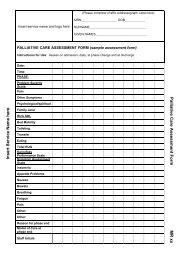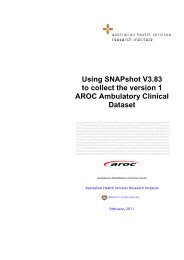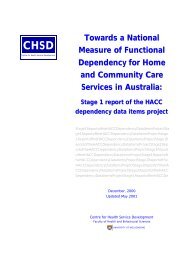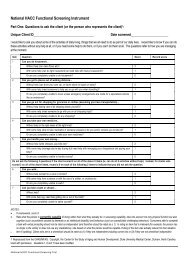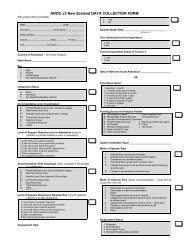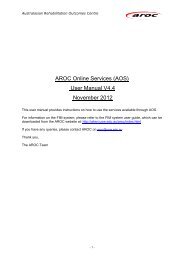[Insert Service Name Here] P C O C A S S E S S M E N T
[Insert Service Name Here] P C O C A S S E S S M E N T
[Insert Service Name Here] P C O C A S S E S S M E N T
Create successful ePaper yourself
Turn your PDF publications into a flip-book with our unique Google optimized e-Paper software.
[<strong>Insert</strong> <strong>Service</strong> <strong>Name</strong> <strong>Here</strong>]PCOC AssessmentInstructions: [<strong>Insert</strong> here]Year 20Date(Please complete or affix Label here)URN:SurnameFirst name:DOB:Sex: * Male * FemalePostcode:Version 1.2 January 2012ClinicianRatedScorePatientRatedScorePhase (1-5)TimeRUG ADL (total 4-18)Bed MobilityToiletingTransfersEatingTotal RUG:Problem Severity Score (0-3)PainOther SymptomsPsychological/SpiritualFamily / CarerAustralian modifiedKarnofsky (10-100)Symptom Assessment Scale (0-10)Difficulty sleepingAppetite problemsNauseaBowel problemsBreathing problemsFatiguePainPatient = ptProxy = prReason for Phase End (1-4)Staff Initials:PCOC ASSESSMENT
PALLIATIVE CARE PHASEClinician rated1.2.3.4.5.STABLE Symptoms are adequately controlled byestablished managementUNSTABLE Development of a new problem or a rapidincrease in the severity of existing problemsDETERIORATING Gradual worsening of existingsymptoms or the development of new but expectedproblemsTERMINAL Death likely in a matter of daysBEREAVED Death of a patient has occurred and thecarers are grievingPROBLEM SEVERITY SCOREClinician ratedFor the following 4 items assess the severity of problems as;0 = Absent; 1 = Mild; 2 = Moderate; 3 = SeverePAIN:Record the severity of problems relating to painOTHER SYMPTOMS:Record the severity of problems relating to other symptoms.The following list may be used as a guide:Nausea/vomiting; Anorexia; Itch/irritation;Constipation/diarrhoea; Wound/ulcer; Incontinence;Weakness/fatigue; Oedema; Dyspnoea; Confusion/delirium.PSYCHOLOGICAL / SPIRITUAL:Record the severity of psychological/spiritual problems of thepatient.The following list may be used as a guide:Anxiety/fear; Request to die; Anger; Depression/sadness;Unrealistic goals; Confusion; Agitation.FAMILY / CARER:Record the severity of family/carer problems.The following list may is a guide:Denial; Anger; Caregiver fatigue; Sensory impairment;Unrealistic goals; Financial; Family/carer conflict;Difficult communication; Non-English speaking; Legal;Family/carer anxiety; Accommodation; Cultural.SYMPTOM ASSESSMENT SCALEPatient rated, proxy when patient unableThe patient is asked to rate distress relating to eachsymptom from 0 being none at all to 10 being worst possible.As part of your assessment, inform the patient that you aregoing to ask them about the symptoms they may beexperiencing or the symptoms that are causing a problem.When asking about these symptoms for the 1 st time, say:“The symptom assessment scale measurescommon symptoms you may experience on a scaleof 0-10. The score can help you to talk about whatis important to you and can help identify thedistress each symptom is causing. The score canalso be used to see whether treatments ormedications are working”.RUG-ADLResource Utilisation Group – Activities of Daily LivingClinician ratedFor Bed Mobility, Toiletingand Transfers1. Independent orsupervision only3. Limited physicalassistance4. Other than two personphysical assist5. Two or more personphysical assistAKPSFor Eating1. Independent orsupervision only2. Limited assistance3. Extensiveassistance/totaldependence/tubefedAustralian modified Karnofsky Performance ScaleClinician rated100Normal, no complaints or evidence ofdisease90 Able to carry on normal activity, minorsigns or activity80 Normal activity with effort, some signs orsymptoms of disease70 Care for self, unable to carry on normalactivity or to do active work60 Occasional assistance but is able to carefor most needs50 Requires considerable assistance andfrequent medical care40 In bed more that 50% of the time30 Almost completely bedfast20 Totally bedfast & requiring nursing care byprofessionals and/or family10 Comatose or barely rousable0 DeadWhere a person cannot rate the symptom, assign thenumber that most closely matches your clinicalassessment. Alternatively, you can ask a carer to rateeach symptom. This is called a proxy assessment.1. Difficulty sleeping2. Appetite problems3. Nausea4. Bowel problems5. Breathing problems6. Fatigue7. PainPlease note that this is a measure of distresscaused by each symptom, not a measure ofseverity or intensity.REASON FOR PHASE END - the reason this phase ended.If the reason for phase change is bereaved, record 3 Died. At the end of bereaved phase, record 4.1. Phase Change2. Discharge/Case closure3. Died4. Bereavement phase end4.


![[Insert Service Name Here] P C O C A S S E S S M E N T](https://img.yumpu.com/41607935/1/500x640/insert-service-name-here-p-c-o-c-a-s-s-e-s-s-m-e-n-t.jpg)

